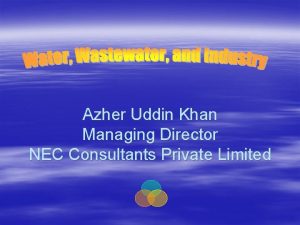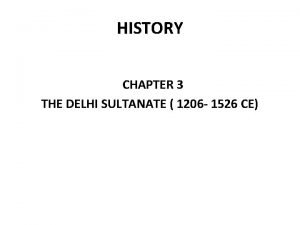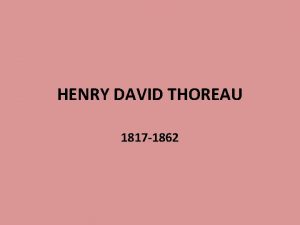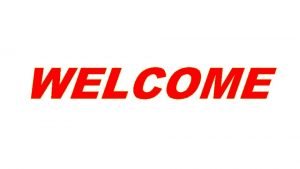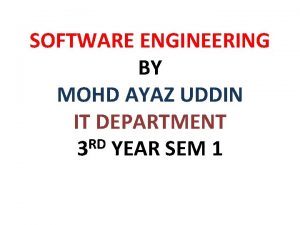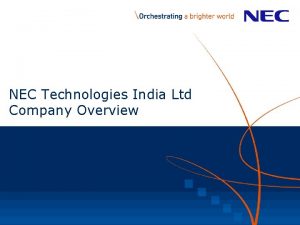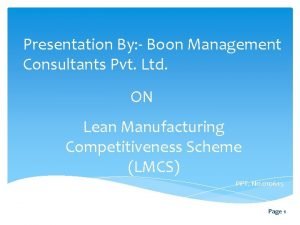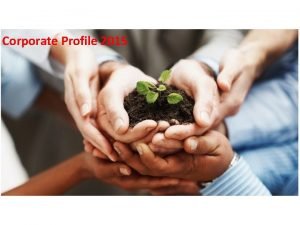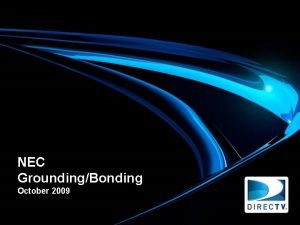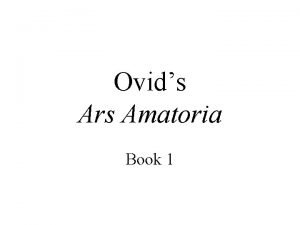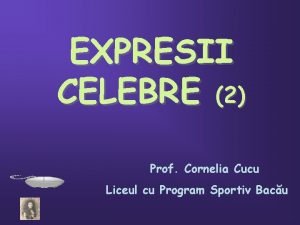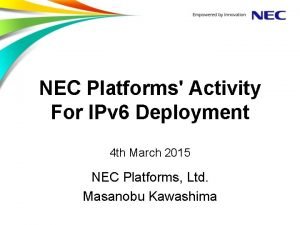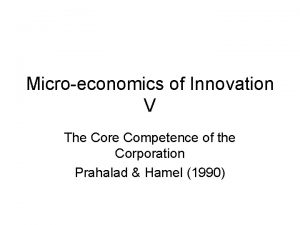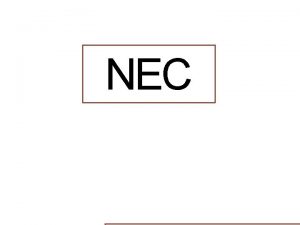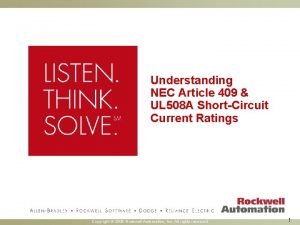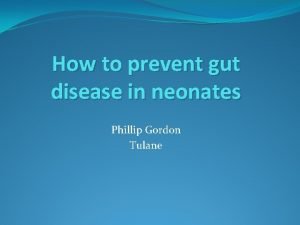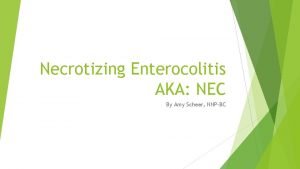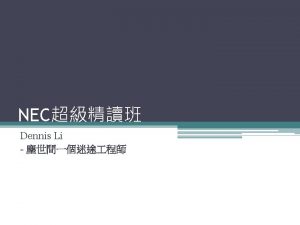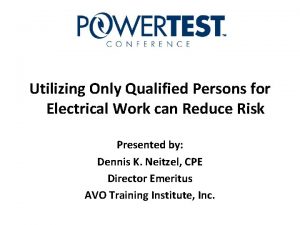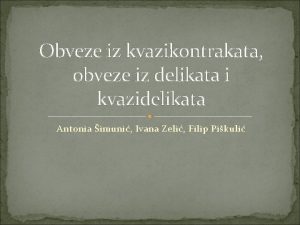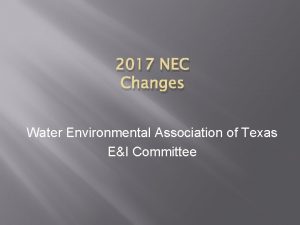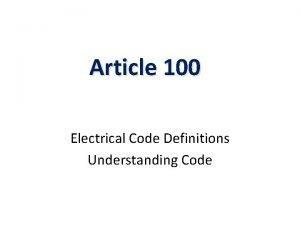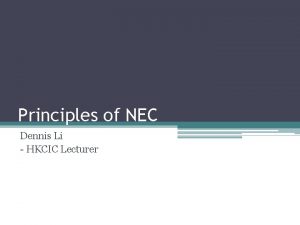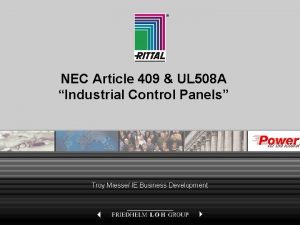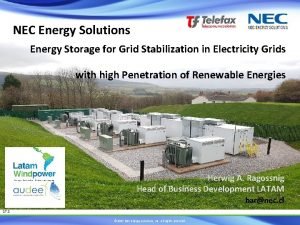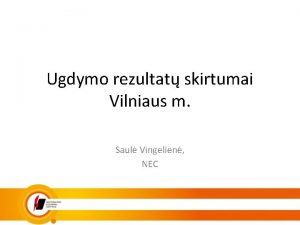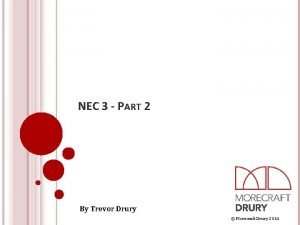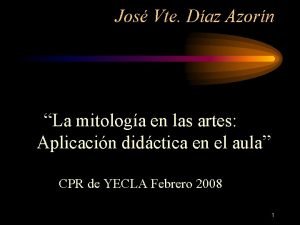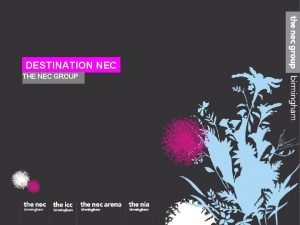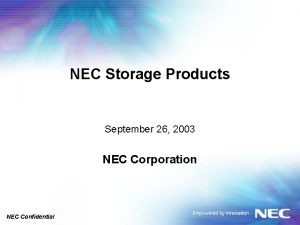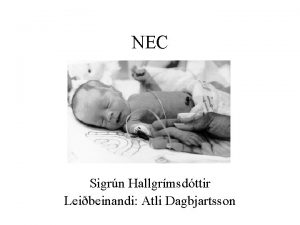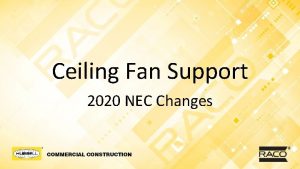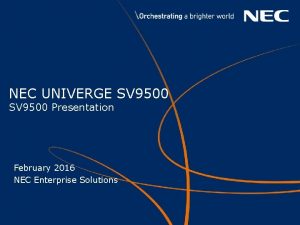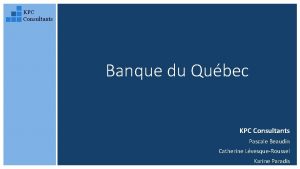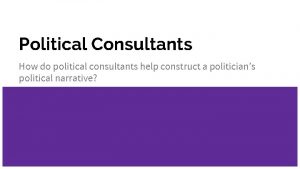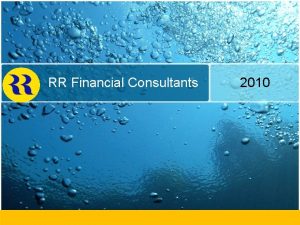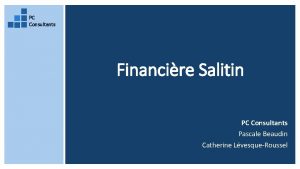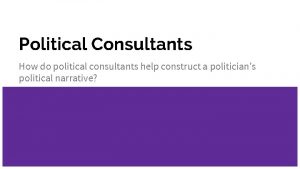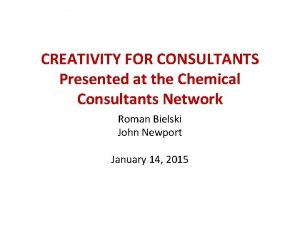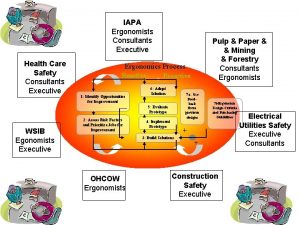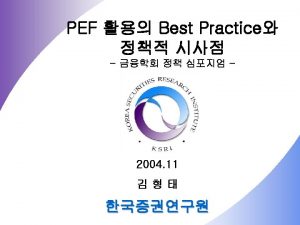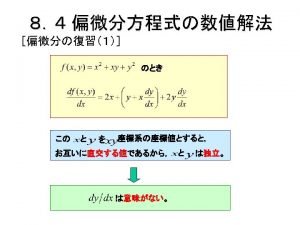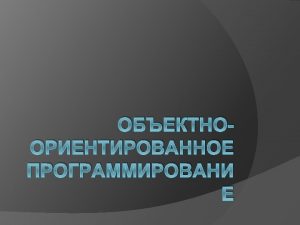Azher Uddin Khan Managing Director NEC Consultants Private































- Slides: 31

Azher Uddin Khan Managing Director NEC Consultants Private Limited

Sources § The World Bank, “Evaluation of Industrial Environmental Management-Pakistan”, 2010 § Cleaner Production Institute, “Program for Industrial Sustainable Development” 2007 -2013 § Cleaner Production Institute, “Environmental Improvement in Pakistan: The Way Forward”, 2013 § WWF-UK and Cleaner Production Institute, “City-wide Partnership for Sustainable Water Use and Water Stewardship in SMEs in Lahore, Pakistan (WSP)”, Switch Asia, 2012 -2105 § Urban Unit, “Energy Audit of 1, 600 tube wells and disposal pumps of Five Major Cities of Punjab”, The World Bank, 2016. § Combined Effluent Treatment Plants for S-III Project-Karachi, Kornagi Tanneries-Karachi, Sundar Industrial Estate, Faisalabad Industrial Estate, Qauid-e-Azam Industrial Estate, National Industrial Parks, and more than 200 industrial units. Slide # 1

Industry and Wastewater Profile of Pakistan § Small industrial base and bound to grow; § About 20 large and 80 small industrial estates are operating without any wastewater treatment facilities; § About 20% of industrial units are highly polluting with respect to wastewater pollution loading; § The major industries are: oil refineries, textile, pharmaceutical, chemicals (organic and inorganic), food industries, ceramics, steel, sugar mills, paper mills, oil mills and leather tanning etc. ; § Largest concentrations of industries are in Karachi and central Punjab; § Estimated shares of municipal and industrial wastewaters discharges are 70% and 30%, respectively; § Estimated shares of municipal and industrial pollution loading are 50% each. Slide # 2

Industry and Wastewater Profile of Pakistan § Estimated wastewater discharges in the sea is 2 -3 MCM per day, and share of industrial wastewater discharges is about 0. 50 -0. 75 MCM per day; § Estimated inland wastewater discharges are 6 -9 MCM per day, and industrial wastewater discharges are 2 -3 MCM per day; § Punjab represents about 65% of inland industrial wastewater discharges i. e. 1. 5 -2. 0 MCM per day; § Potential of polluting 20 times fresh surface water resources of its volume; § Already polluted fresh water groundwater resources in cities. Slide # 3

Estimated Pollution Loads by Biological Parameters and Treatment Cost (Margin of Error +/-20%) Biological Parameters 2017 (Ton Per Day) 2025 (Ton Per Day) Inland In sea Total BOD 5 8, 300 1, 350 9, 650 11, 350 1, 800 13, 150 Total COD 18, 550 3, 000 21, 550 25, 500 4, 000 29, 500 Total TSS 90, 000 2, 900 92, 900 124, 000 3, 800 127, 800 7. 5 2. 5 10. 0 11. 0 4. 0 15. 0 Wastewater discharges (MCM Per Day) Total Inland In sea Total Estimated Treatment Cost (Rs. Billion) 250 375 50% of this cost is for Industrial Wastewater Treatment 125 188 Slide # 4

Concentrations at Discharge Point and Drain Confluence for Common Parameters of Wastewater Common Parameters BOD Expected concentrations of effluent (mg/liter) Concentration of Standards drain effluent prior (mg/liter) to discharge of effluent (mg/liter) 350 -700 135 -200 80 COD 700 -1400 200 -400 150 TSS 300 -600 07 -14 200 Source: Cleaner Production Institute Database Slide # 5

Length of Major Rivers Where Water Quality is Affected by Human Activity Source: Ministry of Water and Power, “Pakistan Water Sector Strategy: National Water Sector Profile”, Volume 5, October 2002 Notes: a-Length of the river reaches adjoining to cities and villages b-12% length of the river reported to have depleted DO c-Length of the river reach between Lahore and Balloki d-24% of length of the river reported to have no DO during low flow period, which is prevalent except for the monsoon season e-Lengths of the river reaches between Peshawar and Nowshehra Slide # 6

Rivers Water Quality Monitoring of Dissolved Oxygen (DO) Data 2010 -12 Rivers KABUL HARO SOAN JHELUM CHENAB RAVI Vicinity of Lahore Downstream of Lahore SUTLEJ NO of Samples 24 12 12 24 48 36 36 DO Concentration (mg/l) Min 5. 7 6. 2 0. 2 6. 1 2. 3 0. 1 0. 3 Median 8. 1 2. 0 8. 1 7. 3 6. 8 6. 4 Max 8. 8 9. 2 6. 4 9. 3 9. 0 8. 7 Percentage within Criteria Value (4 mg/l) 100 17 100 98 78 86 41 4. 6 6. 7 10. 5 100 INDUS 93 5. 1 7. 8 10. 0 100 Source: Environmental Improvement in Pakistan: The Way Forward”, 2013 research study – Overall 326 0. 1 7. 4 10. 50 93 Conducted by Cleaner Production Institute Slide # 7

A Qualitative Comparison of Alternate Biological Treatment Processes Parameter Activated Sludge Trickling Filters UASB Reactors OP & CW Typical BOD Removal Efficiencies > 90 % 70 – 80 % 60 – 75 % Plant Area Requirement Minimum: of the Same Order Operation and Maintenance Cost High Moderate Low Process Energy Requirement High Moderate Low Operational Supervision & Control High Moderate Construction Cost High: of the Same Order Capital Cost High: of the Same Order Process Mechanical Equipment Yes No Quantities of Sludge Produced High Low OP: Oxidation Ponds CW: Constructed Wetlands [1]Largely depends upon the cost of land 70 – 80 % Very High Minimum Nil Minimum Moderate High [1] No Minimum Source: Environmental Improvement in Pakistan: The Way Forward”, 2013 research study – Conducted by Cleaner Production Institute Slide # 8

Major Questions § What to treat: – Heavy Metals – BOD, COD, TSS § Where to treat: – At industry discharge point – At industrial estate discharge point – At drains discharge point to the river § How to treat – Heavy metal recovery plants – Individual treatment plants – Combined effluent treatment plants § What to conserve – Water, chemicals, and energy

General Framework of Cleaner Production is a series of environmental solutions, implemented in a logical sequence of small steps that leads to much smaller and cost effective end-of-pipe solutions. Slide # 9

Relevant Industrial Sectors Ø Ø Ø Leather Pulp and Paper Edible Oils and Ghee Sugar Fertilizer Textile Cotton Processing Slide # 10

Relevant Industrial Sectors Ø Petro Chemicals Ø Dairy Ø Industrial Chemicals Ø Steel Ø Pesticides and Insecticides Ø Automobile Ø Dyes and Pigments Ø Textile Polyester Ø Cement Processing Ø Pharmaceuticals Slide # 11

Approaches for Cleaner Production United Nations Industrial Development Organization promotes eight approaches for minimizing waste at source. Ø Ø Ø Ø Good House Keeping Better Process Controls Equipment Modification On-site Recovery/Reuse Production of Useful By-Products Input Substitution Technology Change Product Modification Slide # 12

Out of eight UNIDO CP approaches, practical implementation experience exists for five approaches: List of Cleaner Production Option. pdf Ø Ø Ø Good House Keeping Better Process Controls Equipment Modification On-site Recovery/Reuse Production of Useful By-Products Slide # 13

Good House Keeping Good house keeping includes resource conservation and better working practices. Relevant Industrial Sectors: Paper, Leather, Textile, Sugar, Pharmaceutical, Edible Oil, Dairies, Industrial Chemical, Pesticides & Insecticides, and Dyes and Pigments. Water Conservation Measures: Ø Ø Adoption of batch washing instead of continuous washing Controlled water utilization for floor washing Recycling the water of vacuum presses Installation of flow measurement valves Slide # 14

Good House Keeping Ø Ø Optimisation of recycling of water Installation of high pressures nozzles for high speed filtration Improving the efficiency of vacuum pumps for recycling Proper coordination between in-charges of different processes for optimising water conservation Implementation of these measures has reduced the water consumption in the range of 30 -50%. Slide # 15

Good House Keeping – Other Cleaner Production Options Ø Ø Training on environmental Auditing, monitoring, environmental management system, ISO 14000 frameworks, and good working practices. Improvement in raw material storage and handling Spillage control of molasses, fibres, trimmings, fleshing in the drains Proper management of hazardous chemicals and wastes Reduction in Hydraulic Load: Pollution Load Reduction: 30 -40% 7 -10% Slide # 16

Better Process Control Better process control includes the modification of working procedures, machine instructions, and process record keeping. Relevant Industrial Sectors: Sugar, Leather, Textile, Paper, Edible Oil, Fertilizer, Petrochemical, Cement, Steel, and Automobile. Ø Ø Improvement of gear boxes, bearings, and other equipment Installation of oil skimmers Establishment of in-house environmental laboratories Improvement in the efficiency of evaporators Slide # 17

Better Process Control Ø Ø Ø Ø Fly ash removal from scrubbing water Salts minimization in wastewater Application of biodegradable and less hazardous chemicals Better fixation of chemicals and optimised recipes formulations Reduction of hazardous wastes Pre-cleaning of the raw material with dry and wet processes Counter current washings Reduction in pollution load: 8 -15% Slide # 18

Equipment Modification Equipment modifications are mostly opted for increasing the efficiency of the manufacturing process and reducing the pollution load. Relevant Industrial Sector: Textile, Paper, Sugar, Pesticides & Insecticide, Cement, and Pharmaceutical. Installation of economizer and condenser to reduce the natural resource consumption and air emissions. Slide # 19

Equipment Modification Ø Ø Ø Shift from co-current mode to regeneration of resin to counter current to reduce boiler blow down, salt & chemical consumption, and water and gas consumption. Installation of reverse osmosis plant to reduce wastewater generation and gas consumption Pulp-dewatering Insulation of digesters High pressure nozzles Reduction in Pollution Load = 10 -20% Slide # 20

On-site Recovery/reuse On-site recovery and reuse options are implemented with the objectives of recycling of waste materials, reduction in pollution load, and generating extra revenue for the companies. Relevant Industrial Sectors: Leather, Sugar, Paper, Textile, Petrochemical, and Cement. Ø Ø Chrome recovery and re-use plant in tanneries Recycling of sulphide liquor after removal of hairs in tanneries. Slide # 21

On-site Recovery/reuse Ø Recovery of oil through oil skimmer in sugar mill Ø Fibre recovery and re-use of caustic after processes of mercerising and scouring in textile mills. Ø Optimising the operations of heat exchangers for energy efficiency in textile mills. Efficiency: 70 -98% recovery of reusable material, pay back period 6 months to one year. Slide # 22

Production of Useful By-products This option is applies to transform the generated waste into material that can be reused for other applications outside the company. For Example: Ø In tanneries fleshing and trimmings of wet-blue leather can be used for chicken feed, leather board, and glue manufacturing. Ø In paper mills the recovered fibre can be used for manufacturing of paperboard. Ø Manufacturing of compost by mixing the mud cakes with the distillery wastewater. Slide # 23

Business Case for Water Conservation Business Case Scenario Textile Tannery Paper Sugar I S P 01 0. 8 -2. 6 1. 7 -4. 9 6 1. 0 -2. 8 3. 1 -6. 7 5 0. 6 -2. 1 1. 2 -3. 8 7 1. 0 -3. 0 2. 5 -6. 4 6 02 11. 823. 4 8. 5 -15. 8 18 12. 625. 8 8. 5 -16. 2 19 13. 326. 4 6. 9 -14. 0 23 12. 825. 6 6. 112. 5 25 03 12. 626. 1 10. 120. 7 15 13. 728. 7 11. 722. 9 15 13. 928. 5 8. 2 -17. 9 20 13. 828. 618. 9 19 I=Investment (Rs. Million), S=Savings (Rs. Million), and P=Payback Period Source: City-wide Partnership for Sustainable Water Use and Water Stewardship in SMEs in Lahore, Pakistan Slide # 26

Financial Viability of Environmental Investments in Dyeing Mills(Rupees in Million) Investments/Savings Year-1 Year-2 Year-3 Year-4 Year-5 Total Capital Investment 3. 36 8. 03 10. 04 3. 03 34. 50 Saving (CP + Charge) 6. 10 6. 58 7. 54 8. 26 8. 98 37. 47 Net Savings 2. 74 -1. 45 -2. 50 -1. 78 5. 95 2. 97 - 1. 29 -1. 20 -2. 99 2. 97 Capital Investment 2. 48 2. 03 5. 04 1. 53 16. 12 Saving (CP + Change) 3. 11 3. 35 3. 84 4. 20 4. 57 19. 07 Net Savings 0. 63 1. 32 -1. 20 -0. 83 3. 03 2. 95 - 1. 95 0. 75 -0. 08 2. 95 Capital Investment 1. 88 3. 04 0. 73 9. 42 Saving (CP + Charge) 1. 70 1. 84 2. 12 2. 32 2. 59 10. 51 Net Savings -0. 18 -1. 20 -0. 92 1. 59 1. 79 1. 09 - -1. 38 -2. 30 -0. 71 1. 09 Large Dyeing Mills Cumulative Saving Medium Dyeing Mills Cumulative Saving Small Dyeing Mills Cumulative Saving Note: Totals do not tally due to rounding error. Slide # 24

Recommendations q q Cleaner Production can be best implemented under a solution development framework under which all pollution prevention options at source and resource conservation options at the process level are investigated and implemented which have direct impact on the size and cost of the end-of-pipe treatment systems’. CP options offer about 30% reduction in the size of environmental investments. These are easy to implement and are sustainable with good financial paybacks. Slide # 27

Recommendations q q q CP options can be best implemented with the involvement of industry technicians and management. Process technologist develops the most effective solutions after the identification of environmental problem by the environmental engineers. Best tools for identifying the areas of CP options implementation are material balances and water balances. CP options are not replacement to end-of-pipe treatment systems in all cases. These have the potential to reduce the size of end-of-pipe treatment and resource conservation. Slide # 28

Recommendations q. Provide legal cover to cleaner production Options under PEPA’s. q. Adopt a realistic and practicable holistic approach, originating from the natural waters and ending at the required wastewater treatment. q. Establish the ambient water quality requirements or standards, for the natural water bodies. q. Provide and operate combined public wastewater treatment systems, for achieving the established ambient water quality standards in the receiving surface waters. Slide # 30

Recommendations q Public organizations, responsible for the execution and OM of the combined wastewater treatment facilities, to be separated from the respective environmental regulatory bodies, in their structure and functioning. OM of the combined wastewater treatment facilities may be outsourced to private water companies, to off-load the governments. q The federal and provincial governments shall, within their areas of jurisdiction, levy and collect appropriate Environmental Charges, on account of the provision of combined treatment facilities, from different categories of the polluters, connected to these facilities. q Treatment for Specific pollutants at source, to comply with the specified Emission Standards, and not at the combined treatment facilities Slide # 30
 Nec managing director
Nec managing director Ziauddin barani
Ziauddin barani Ophiasis
Ophiasis Mir camar uddin mast
Mir camar uddin mast Furkan uddin
Furkan uddin Aiyaz uddin
Aiyaz uddin Nec hcl system technologies limited
Nec hcl system technologies limited Boon management consultants private limited
Boon management consultants private limited Managing director titles
Managing director titles Managing director message for company profile
Managing director message for company profile Nec 250 122
Nec 250 122 Proteus fiet nunc unda
Proteus fiet nunc unda Nec pluribus impar
Nec pluribus impar Aterm wh832
Aterm wh832 The core competence of the corporation
The core competence of the corporation Nec diagnosis
Nec diagnosis Table sb4.2
Table sb4.2 Nn1099 nec
Nn1099 nec What is nec in babies
What is nec in babies What is nec
What is nec Nec activity schedule example
Nec activity schedule example What is the nec definition of a qualified person?
What is the nec definition of a qualified person? Furtuma
Furtuma Nec 250 122
Nec 250 122 A feeder consists of all circuit conductors located ____
A feeder consists of all circuit conductors located ____ Devb nec
Devb nec Cinder
Cinder Article 409
Article 409 Nec energy solutions
Nec energy solutions Nec pupp
Nec pupp Nec weather records
Nec weather records Nec daz
Nec daz
